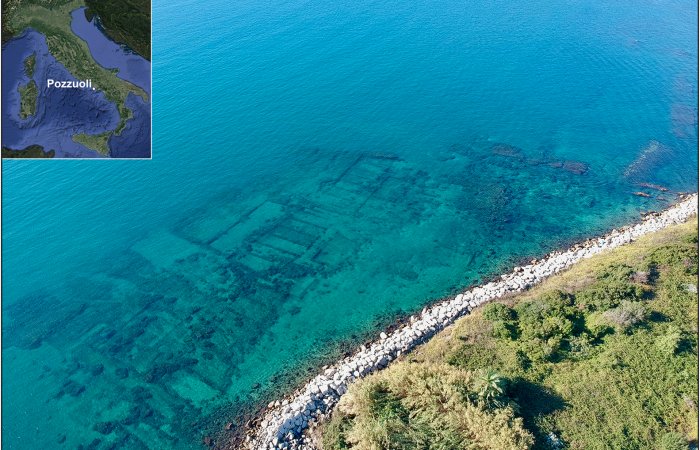Jan Bartek – AncientPages.com – It is not uncommon for archaeologists to uncover submerged ancient ruins in the waters of Italy. However, these ancient structures are sometimes not easily discernible. For instance, the recent discovery of the Nabataean underwater temple underscores how certain ancient ruins are situated at depths that render them undetectable from aerial observation.
Submerged warehouses in the ripa Puteolana. Credit: M. Stefanile et al., Antiquity
The Phlaegrean coast near Naples, Italy, has been significantly influenced by a series of geological events and the ongoing uplift and subsidence of the land. Volcanic activity in this region has shaped its landscape and preserved rich archaeological evidence beneath the current sea level.
During the Augustan era (31 B.C.-A.D. 14), this area was a prime example of urban planning and architectural development within a bustling port district that played a crucial role in maritime trade, especially in grain distribution. Puteoli’s importance in complex mercantile networks is reflected in the layout of its storage facilities. The oldest facilities, dating from the second to first centuries B.C., are located in Rione Terra, while newer ones from the Augustan era are distributed throughout the city near the port and major roadways.
Nabataean temple: a) altar A1; b) altar A2; c) slab L1; d) slab L4. Credit: M. Stefanile et al., Antiquity
Researchers have recently discovered and examined a submerged Nabataean temple at Puteoli’s port. This finding is particularly unique as it represents the only known Nabataean temple outside of Nabataea, which lies between the Arabian and Sinai Peninsulas. Last year, scientists discovered an amazing submerged ancient temple with marble altars at the site, and the new study sheds more light on this fascinating discovery.
The discovery forms a significant part of the broader project “Between Land and Sea,” an initiative spearheaded by the Italian Ministry of Culture and the University of Campania to explore the area’s underwater treasures. Puteoli, originally established as a Greek colony named Dicaearchia in the 5th century BC, was subsequently annexed by Rome following the First Samnite War in 343–341 BC (the Samnites being an ancient people residing in central Italy).
Owing to its strategic location, this port city evolved into a pivotal trade hub where goods from across the Roman world converged. Notably, grain shipments from Alexandria in Egypt were vital for sustaining the empire. The unexpected discovery of a Nabataean temple is particularly intriguing, given that this site has predominantly been regarded as a Roman settlement.
The presence of a Nabataean sanctuary within the port area clearly indicates that a community from that region actively participated in Puteoli’s commercial activities. This integration is demonstrated by the building techniques and materials used in constructing the temple, as well as the choice to use Latin for inscriptions dedicated to their supreme deity, Dushara, lord of the mountains and germinating force of nature.
The construction of this sanctuary was possible during a period when the Nabataeans enjoyed both friendly relations with Rome and independence in their homeland. This era, which spanned from Augustus to Trajan (AD 98–117), was marked by significant wealth accumulation for the Nabataeans. They were deeply involved in Mediterranean trade, controlling Eastern luxury goods traffic from the Indian Ocean along desert caravan routes to Gaza’s port and onward to Rome, likely through Alexandria and certainly through Puteoli.
Orthophoto of the ripa Puteolana. Credit: M. Stefanile et al., Antiquity
However, under Trajan’s rule, this favorable situation changed dramatically, with Arabia Petraea becoming a Roman province. This development had significant consequences: Rome imposed its authority and legal framework while integrating trade routes into a state-controlled network, leaving little room for initiatives by what had become a subjugated people.
Scholars have determined that the temple is comprised of two rooms, Room A and Room B. In Room A, two white marble altars were discovered, with the larger altar featuring eight rectangular holes thought to have held sacred stones used by the Nabataeans in their religious practices. Additionally, a substantial marble block bears the Latin inscription “Dusari sacrum,” signifying that the temple was dedicated to Dushara, the principal deity of Nabatean worship.
See also: More Archaeology News
Puteoli served as a significant port for many centuries but suffered attacks by Germanic tribes in 410, 455, and 545. These invasions led to its decline and eventual disrepair. In subsequent centuries, active volcanic activity in the region caused extensive portions of Puteoli to submerge into the sea.
The study was published in the journal Antiquity
Written by Jan Bartek – AncientPages.com Staff Writer








